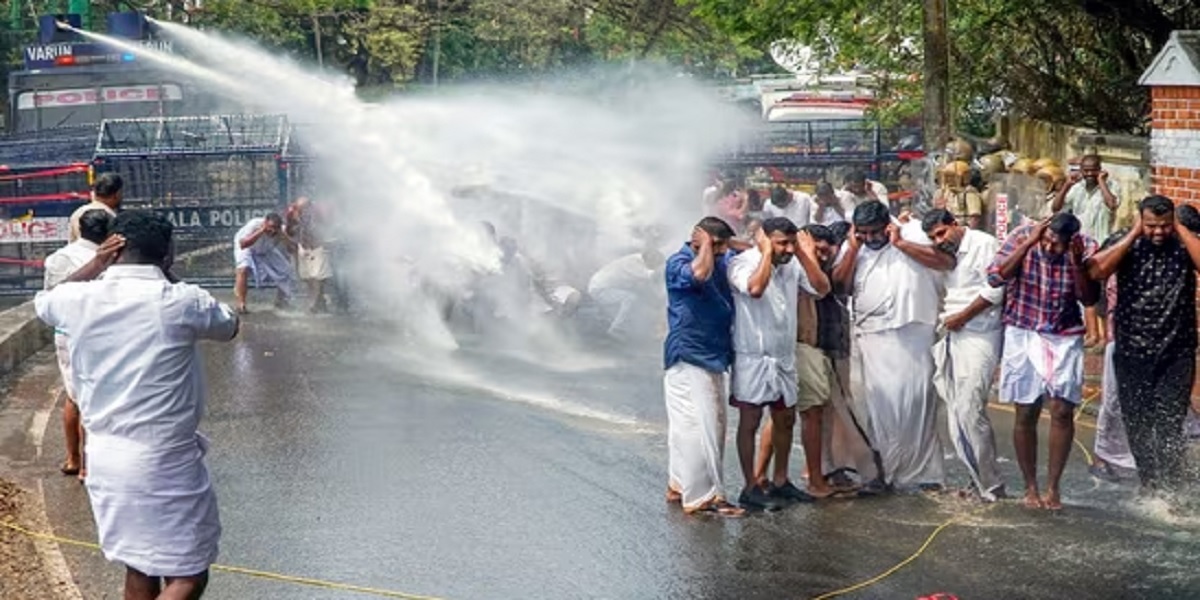An expert in Community Medicine said thought chances of infection through water cannons are theoretically possible, no study has been conducted so far.
Published Sep 25, 2025 | 9:00 AM ⚊ Updated Sep 25, 2025 | 9:00 AM

The use of untreated or non-chlorinated water in police water cannons could pose serious health risks, particularly if it comes into contact with the face, nose, or mouth.
Synopsis: Protests are part of life in Kerala, and the police using water cannons to disperse crowds are not new. However, with a spike in Primary Amoebic Meningoencephalitis caused by the brain-eating amoeba, concerns have been raised over the water used to control crowds.
A new fear has gripped the anti-government protesters in Kerala — and the State Human Rights Commission (SHRC) is not amused.
Activists of the opposition parties are used to police lathi-charge, stun grenades, and water cannons. The protesters now fear that they are facing a threat from a unicellular organism, the Naegleria fowleri.
With Kerala facing a spike in Primary Amoebic Meningoencephalitis (PAM), the protesters are worried that the deadly brain-eating amoeba could be transmitted through water used in the cannons.
The state has so far reported 77 confirmed PAM cases and 21 deaths.
An expert in Community Medicine said there could be substance in the fear, though it has not been scientifically substantiated. Even as a section of police officer said the water used was safe, doubts remain over the water-filling points.
Ernakulam District Vice President of the Youth Congress, Salman Olickal, is one among many who expressed fear that the deadly amoeba could be transmitted through the water police use against them.

Varun, a water cannon-mounted crowd control system developed by DRDO.
He approached the SHRC and the State Police Chief, complaining about the use of untreated water in cannons. The SHRC has now registered a case (No. 7373/11/3/2025).
Olickal raised serious concerns about public health and human rights in crowd management operations. He highlighted the PAM threat Kerala has been facing.
”The use of untreated or non-chlorinated water in police water cannons could pose serious health risks, particularly if it comes into contact with the face, nose, or mouth,” the Youth Congress leader told South First.
He urged the authorities to ensure that the water is adequately treated, chlorinated, and disinfected before use.
”It is crucial to assess the potential health risks and human rights implications of exposing citizens to untreated water, especially during an infectious disease threat,” he added.
Emphasising the urgency in ensuring safe water, he said, ”The SHRC and police authorities must ensure proper treatment and chlorination of water before deployment, and issue immediate guidelines to protect citizens’ right to health and life during law enforcement operations.”
Olickal stressed that safeguarding public health must be a priority in all crowd management practices and requested the Commission to take action or issue appropriate directions promptly. He also sought clarification from the State Police Chief: ”If the water is not treated or chlorinated, steps must be taken immediately to ensure public health is protected.”
Jaisal, another Youth Congress leader from Ernakulam, felt the water used against protesters was not properly treated.
He had tried everything to his trademark spotless white shirt, the unofficial politician’s uniform, from mud stains and chemical-like particles after protests. He had tried even the newest available lotions and stain removers, but after each protest where water cannons were used, he lost a shirt.
”Nowadays, after the police use water cannons, we struggle with stains. There is even a foul smell that sticks to us,” Jaisal told South First.
Anusha, a KSU activist from Palakkad, recounted her experience facing police water cannons.
‘Typically, the police sound a siren before using it, a warning for the crowd to disperse. We form small groups and hold hands tightly; otherwise, the force of the water can knock us down and cause injuries,” she told South First.
When the siren goes off, we block our ears with fingers or cotton because if the water enters, it can affect balance and make us fall,” she added.
Dr Anish TS, Assistant Professor of Community Medicine at Thiruvananthapuram Medical College, did not totally rule out Olickal’s concern.
”Theoretically, there are risk factors (in splashing water), but no specific study has been conducted on health hazards linked to water cannons. Using untreated or non-chlorinated water can spread infectious diseases, and those with weaker immunity are more vulnerable,” he told South First.
He added that Kerala, along with ICMR, would soon launch a study on amoebic meningoencephalitis, after which a proper action plan could be drawn.
An officer attached to the Armed Reserve (AR) Police camp in Thiruvananthapuram said water cannons were earlier filled from the Kerala Water Authority’s facility around three kilometres away. Now, the vehicles were being filled from a water body in the camp.
He also said that the old practice of using coloured water to mark protesters was discontinued following health concerns over the chemicals mixed in the water.
Senior police officials, however, insisted there was no risk in the water used. ”We do not draw water from rivers or canals, as protesters claim. The supply comes from the KWA’s charging point at Vellayambalam,” an officer said, contrary to what was earlier told.
“Each tanker carries 12,000 litres and is refilled daily. If the tank runs out during continuous use, usually in about five minutes, the Fire Force assists us in refilling while we manage the crowd,” he added.
Fire officers Rajesh and Anvin from Kochi told South First that during emergencies, water for firefighting can be drawn from any available source, including station storage tanks, rivers, ponds, hydrants, or high-rise fire-protection systems.
They pointed out that standard fire tenders carry about 4,500–5,000 liters of water, while larger bowsers can store up to 20,000 liters, and the supply has to be refilled after every incident.
Anvin noted that firefighting usually involved direct water contact, but protective gear minimised the risks.
Rajesh added that their station mainly used rainwater collected in sumps and, during summer, water from nearby temple ponds. He said chlorination is unnecessary since the water is not for public use, and chlorine could damage the pumps and tanks.
The Varun, a mounted water cannon system, offers a powerful yet non-lethal method for controlling violent crowds. First introduced in Thiruvananthapuram in 2004, it is now deployed across all police districts across the state.
The system features two rotatable cannons on the vehicle’s roof capable of delivering either continuous or pulsating water jets. There is also an option to mix irritants or indelible ink into the water.
Olickal said people were not opposing the use of the less-aggressive water cannons. However, he emphasised the need for clarity on whether the water could pose any health risks, especially given growing concerns about unsafe water in public sources.
”We trust the police to manage crowds, but our safety and health cannot be overlooked,” he added.
(Edited by Majnu Babu).
